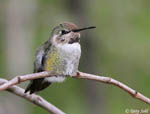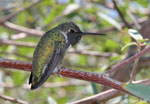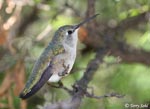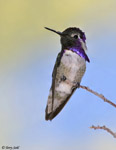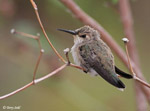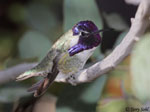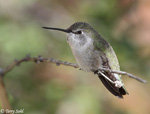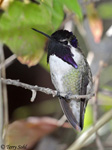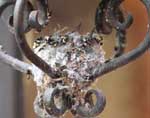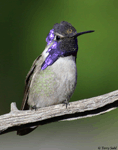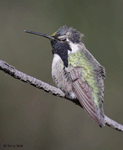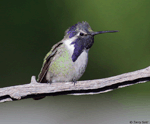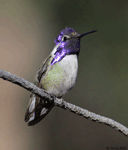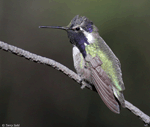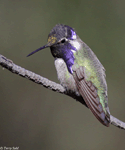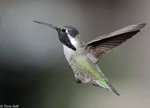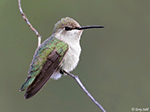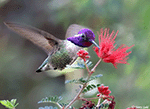Costa's Hummingbird
Calypte costae
| Length: 3.5 inches | Wingspan: 4.75 inches | Seasonality: Extremely rare visitor |
| ID Keys: Small size, stocky build, short-tailed, long purple gorget on male, white eyebrow | ||
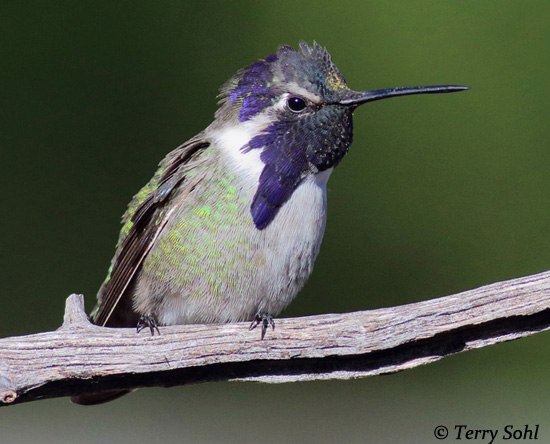 The
U.S. range of the Costa's Hummingbird normally only includes the deserts of the
Southwest. Unlike some other western hummingbird species, they are not
known for often wandering widely from that range, and they are thus only
extremely rare visitors to South Dakota. Males are generally distinctive,
with very long, flared gorgets of a brilliant purple (see photo to the right).
As with other hummingbird species in the West, they have adopted well to a human
presence, with increased numbers and range due to year-round availability of
nectar and flower sources in many urban areas.
The
U.S. range of the Costa's Hummingbird normally only includes the deserts of the
Southwest. Unlike some other western hummingbird species, they are not
known for often wandering widely from that range, and they are thus only
extremely rare visitors to South Dakota. Males are generally distinctive,
with very long, flared gorgets of a brilliant purple (see photo to the right).
As with other hummingbird species in the West, they have adopted well to a human
presence, with increased numbers and range due to year-round availability of
nectar and flower sources in many urban areas.
Habitat: In normal range, typically found in desert habitats, primarily in low washes and streamsides where vegetation is thicker than in the upland desert. Also has adapted to living in urban settings.
Diet: Feeds primarily on nectar, especially from desert plants such as agave and ocotillo.
Behavior: Feeds in typical hummingbird fashion at flowers and other nectar sources.
Breeding: Non-breeder in South Dakota
Song: Has a thin tink call, and high chattery twittery chase calls.
Migration: Birds in the U.S. portion of their range are typically migratory, moving southward into Mexico in winter, although a few remain north of the border. Within the U.S., birds breeding in the desert typically breed in late winter or very early spring, and then move westward to coastal areas for the hottest weather of the summer.
Interactive eBird Map: Click here to access an interactive eBird map of Costa's Hummingbird sightings
Similar Species: Anna's Hummingbird, Black-chinned Hummingbird
Conservation Status: Populations appear to be stable, with local fluctuations where desert habitat has been destroyed.
Further Information:
- USGS Patuxent Bird Identification InfoCenter, Costa's Hummingbird
- Audubon Guide - Costa's Hummingbird
- WhatBird - Costa's Hummingbird
Photo Information: November 11th, 2015 - Santa Rita Lodge, in Madera Canyon south of Tucson, Arizona
Additional Photos: Click on the image chips or text links below for additional, higher-resolution Costa's Hummingbird photos.
| Click on the map below for a higher-resolution view |
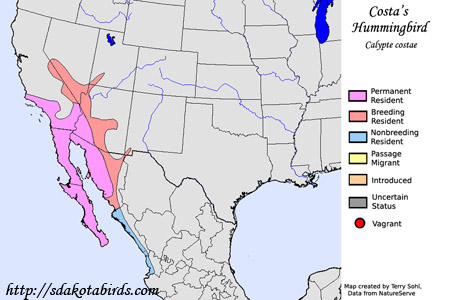 |
| South Dakota Status: Accidental visitor to South Dakota. |
Additional Costa's Hummingbird Photos
Click for a higher-resolution version of these photos
